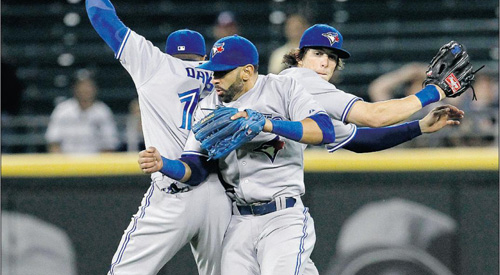
How Colby got his groove back
On June 29th against the Angels, fans in Toronto got a taste of the Colby Rasmus experience. With one out and runners on the corners, Erick Aybar hit a deep fly to center. Rasmus, playing him shallow, turned and ran to his right after the fly ball. He leaped, made the catch and bounced right into the camera lens printed on the wall.
The Angels scored one on the sacrifice fly, but the catch by Rasmus kept Howard Kendrick from scoring and Aybar from reaching base – and probably also reaching scoring position – and he Angels lead was held to just two. All things considered, it was a key out in an eventual 7-5 Jays win.
It’s been a good 2012 for Rasmus. But it has to be: 2011 was a year to forget.
Last season, Rasmus came to Toronto after a falling out with Cardinals manager Tony La Russa, notably when he starting working on hitting with his dad instead of Mark McGuire. He arrived in a three-team deal that sent Edwin Jackson to St. Louis and Jason Frasor to Chicago. “It was a good trade,” said Jays GM Alex Anthopoulos at the time, “all the teams got what they wanted.”
But Rasmus’ first season as a Jay surely wasn’t what Anthopoulos wanted. He finished the season hitting just .173, with an OPS of .517. He knocked in just 13 runs, struck out 39 times and finished with an abysmal WAR of -10. He struck out nearly 28 percent of the time last season. That level of strikeouts is, as Fangraphs bluntly puts it, awful.
[php snippet=1]
Now, the shaggy haired hitter is on fire: in June he posted a .308/.351/.579 triple slash. His strikeouts have remained consistent – around 20 per month – but hit more dingers (eight) and drove in more runs (25) in June than he did throughout the first two months combined (six and 21). Small wonder his OPS skyrocketed from .730 after May to .806 today.
What changed for Rasmus?
The trade certainly was part of it: as Colby’s dad Tony Rasmus said to the National Post’s John Lott, St. Louis was a bad scene. There was the pressure of being a hot prospect, pressure from playing under La Russa, a playoff push and headlines about a meddling father and a team that couldn’t get along. Even now, a year after leaving St. Louis, columnists are still taking shots at Tony Rasmus.
There’s more baseball-related things, too. In 2011, Rasmus struggled against left-handed pitchers: he hit just .215 against them and struck out about 22 percent of the time. This season, he’s hitting .241. While he still doesn’t hit for power against them – his slugging percentage is just .367 against lefties – he’s improving. Another big change is the adjustment in his batting stance: he stands higher at the plate and is more relaxed.
His fielding is top-notch, too. He’s already provided more assists than he had last season and his ultimate zone rating has exploded. Last year, Rasmus finished with an UZR well in the negatives, -8.8. Thus far in 2012, it’s risen above par to 1.2. It’s a long way off from his rookie campaign’s 10.2 UZR, but it’s also the first time it’s been above zero since that season, too. And he’s become the Jays de facto center fielder, playing 76 games out by Windows Restaurant this season.
Last season, Rajai Davis played most of the games in center, finishing with a -7.9 UZR. Almost immediately after arriving in Toronto, Rasmus cemented himself as the anchor of the outfield. Toronto hasn’t had a centerfielder this good since Vernon Wells’ peak in the mid-2000s.
Still, the biggest change with Rasmus this year has been the way he carries himself on the field. There was a cloud around him last year, between his reputation and the circumstances leading him to Toronto. Hhis abysmal year at the plate didn’t help. But this year, he’s emerged as a personable guy in centerfield: even when he does a takeout slide, it’s exaggerated to the point of absurdity.
But even then, Rasmus had a goofy quality to him. A personal anecdote: I sat in the outfield for a game last year for a game Rasmus started. He was still new to the team at this point. There was an over-served individual in my section, yelling at the players throughout the game. When Rasmus relaxed between batters, the guy screamed: “LA RUUUUUUSSA SUUUUUCKS!” Without turning around, Rasmus shot our section the thumbs up.
It’s easy to forget now, but Rasmus’ first season in the majors was really good: he posted an OPS of .714, 1.7 WAR and had a strong showing in the rookie of the year race, all while playing on a 91-win team. Somewhere in the following seasons, he got lost in the plot and needed a fresh start. Not only did he get one in Toronto, but as his June numbers show, he’s making the most of it.
[php snippet=1]

